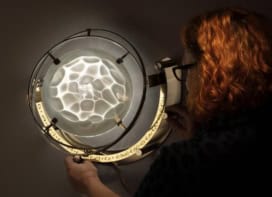
By Tushna Commissariat
This week we heard about a possible new James Bond film villain and its none other than Stephen Hawking. According to this story in the Telegraph, he feels as if his trademark wheelchair and computerized voice would lend themselves perfectly to the part. On the same note, we saw this interesting feature on the Wired website that looks at the history behind Hawking’s very recognisable voice. Last month, I was lucky enough to attend an early screening of James Marsh’s Hawking biopic The Theory of Everything, which includes a rather touching and funny scene of Hawking testing out his voice for the first time. You can read more about the film in the reviews section of the upcoming January issue of Physics World.
Also, launched as of today, you can now freely access the collected and translated papers of Albert Einstein, thanks to the combined efforts of Princeton University Press, in partnership with Tizra, Hebrew University of Jerusalem, and the California Institute of Technology. The Digital Einstein Papers website contains a whopping 5000 documents covering the first 44 years of Einstein’s life, up to and including the award of the Nobel Prize for Physics and his long voyage to the Far East. Along with his research, it also contains more personal documents and letters, and can be viewed in English or German.
Science (and physics especially) has long had a special relationship with cats. This article, on “The 11 most important cats of science”, on the Popular Science website perfectly illustrates the point. My favourite is astronomer Edwin Hubble’s cat, aptly named Nicholas Copernicus, though Félicette – the first cat in space – is very cute too!
Also, be sure to take a look at what physicsworld.com editor Hamish Johnston has to say about his job, as a part of blogger Chad Orzel’s profiles of people with jobs “off the standard academic science track”.



